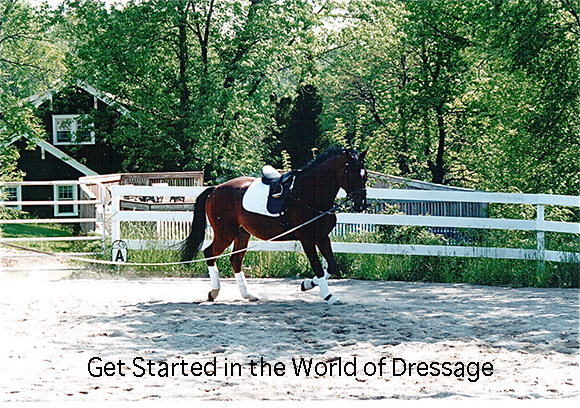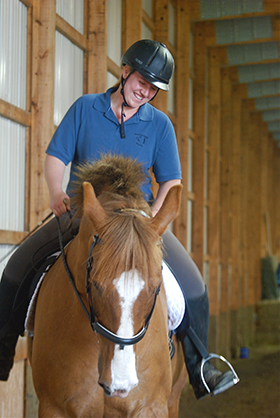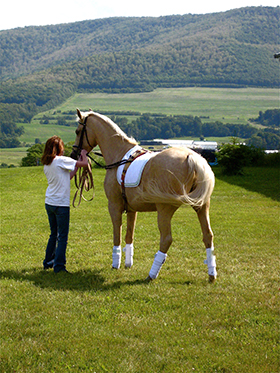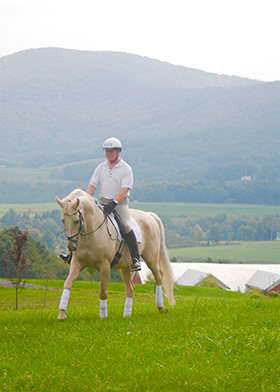Get Started in the World of Dressage
By Nikki Alvin-Smith

Dressage is a fun riding discipline and one I have spent most of my adult life trying to master. Many riders enjoy the mental challenges it provides and the focus that it requires to develop trust and harmony with their horses. My journey has been a varied one. Like many horse crazy kids I began with jumping and loved the thrill of galloping fields, jumping fences (both natural ones on the trail and the pole variety in the ring), and I didn’t turn to dressage until I was a young adult.
I have been blessed to work with some iconic names in the world of dressage that have helped me throughout my career and resulted in success at the international Grand Prix level.
The British in me has kept me very much grounded and down to earth in both how I approach training a horse and in how I teach students at clinics and lesson programs.
It does not matter which discipline you came from or why you have decided to give dressage a try. What matters is your attitude at the start of the process. Let’s take a look at how to enjoy the journey into this wonderful art.
Know the Principles
It always pays to educate yourself at the outset of any new endeavor. Dressage is no different. Pick up a book or two, or a few DVDs and gain some insight into what dressage is all about. Understand the basics of the pyramid and how dressage training must be built on a solid foundation from the outset, in order to succeed either as horse or rider.
Required Rider Talents
 In any horse riding discipline it is important that you have established an independent seat and quiet, kind hands. Before you determine to specialize in dressage it is a great idea to take some lessons on the longe line with a qualified trainer standing in control of the horse, and enjoy some education in how to control your own body through the transitions and gaits of the horse without use of the reins to hold you in the saddle.
In any horse riding discipline it is important that you have established an independent seat and quiet, kind hands. Before you determine to specialize in dressage it is a great idea to take some lessons on the longe line with a qualified trainer standing in control of the horse, and enjoy some education in how to control your own body through the transitions and gaits of the horse without use of the reins to hold you in the saddle.
The trainer should have a great eye and provide significant advice on how you achieve your independent seat. It is not about being blasted around the circle at random speeds and then gripping the saddle with your legs to stay aboard. That is entirely unhelpful. The trainer must have an obedient horse, a quiet manner in their voice and helpful attitude. You do not want to stay on the horse by gripping with your thighs and legs, you want to stay on the horse using your balance. Search for the right help, this will make all the difference.
The Horse
An imperative part of the equation is your horse must be sound. He should not be fearful of you as his rider or of being ridden, as this will create tension and nervousness and he will not be able to relax and focus on your requests.
You do not need to rush out and buy a fancy dressage saddle but your saddle should fit the horse and cause no pain. It should also fit you. If you are a little bigger in the derriere then go to an 18 or 18.5 inch saddle. There is nothing worse than trying to ride in a saddle that is too small. Leave vanity at the barn door! As you progress you can always pick up a used dressage saddle and have it fitted for your horse.
 Bits are necessarily required to be of a certain type to ride in a dressage test. While there are a myriad of variances the principle bit is a snaffle. At our training farm and throughout my career I have always ridden, started our homebred horses and imported horses etc. in a properly fitted loose ring French snaffle. This is the softest of bits when used correctly and while you can use other designs to aid in steering, I prefer to start as I mean to go on. That is, steering the horse with my legs and seat and not relying on my hands.
Bits are necessarily required to be of a certain type to ride in a dressage test. While there are a myriad of variances the principle bit is a snaffle. At our training farm and throughout my career I have always ridden, started our homebred horses and imported horses etc. in a properly fitted loose ring French snaffle. This is the softest of bits when used correctly and while you can use other designs to aid in steering, I prefer to start as I mean to go on. That is, steering the horse with my legs and seat and not relying on my hands.
If you need to teach your horse about contact with the bit, the best place to begin is with longe work with side reins attached to the bit. Voice work on transitions will also provide you with tools to use when you are in the saddle to affect a change in gait without the development of the bad habit of overuse of the rein aids.
Area to Work
While I have taught students in a variety of locations, from grass rings in their back yards to the most elite designed and well-footed arenas, the important factors for any dressage training is the area should be level and the footing consistent and horse-user friendly.
A fenced arena is helpful but not necessary. While I do some dressage training on trail rides, especially such things as teaching the young horse his balance in the early canter, the majority of the work necessarily requires at least a 20 x 40 meter (60 by 135 feet) level space.
Ethical Training
 Your horse must trust your hand and you must learn how to engage your core and work the horse in front of your leg. There are many ways to accomplish this and the process is easy to learn. It doesn’t matter what breed your horse is or even what his conformation is at this point. You are not off to the Olympics. Every horse benefits from working across his topline from back to front, lifting the shoulders and engaging their own cores to carry themselves in self-carriage. There simply are no shortcuts to achieve this. An experienced dressage trainer or judge will immediately know if you have attempted to make any shortcuts either with your work in the saddle, straps or gizmos on the ground. How? By taking a look at the muscle development on your horse. If you consult a good resource you can learn how to evaluate the correctness of your work by learning about muscle development of your horse. For example: When ridden the horse should develop a line of soft rippling muscle from the wither forward to the poll. This muscle should never be taut and rolled like a sausage, but it should be soft and ripple when the horse moves. The muscle should be most developed at the lower end, near the wither in the beginning. Over time it develops to the poll and as you progress to advanced levels if you are working correctly it will become more pronounced and the poll of the horse will always be the highest point when worked to the bridle.
Your horse must trust your hand and you must learn how to engage your core and work the horse in front of your leg. There are many ways to accomplish this and the process is easy to learn. It doesn’t matter what breed your horse is or even what his conformation is at this point. You are not off to the Olympics. Every horse benefits from working across his topline from back to front, lifting the shoulders and engaging their own cores to carry themselves in self-carriage. There simply are no shortcuts to achieve this. An experienced dressage trainer or judge will immediately know if you have attempted to make any shortcuts either with your work in the saddle, straps or gizmos on the ground. How? By taking a look at the muscle development on your horse. If you consult a good resource you can learn how to evaluate the correctness of your work by learning about muscle development of your horse. For example: When ridden the horse should develop a line of soft rippling muscle from the wither forward to the poll. This muscle should never be taut and rolled like a sausage, but it should be soft and ripple when the horse moves. The muscle should be most developed at the lower end, near the wither in the beginning. Over time it develops to the poll and as you progress to advanced levels if you are working correctly it will become more pronounced and the poll of the horse will always be the highest point when worked to the bridle.
You Don’t Know What You Don’t Know
The advice and help of an experienced trainer is worth spending money to attain. Be certain you choose help from someone who has as much experience and proven results/fine reputation as possible, and very importantly has a great attitude to you as a beginner. Too often trainers that work at the higher levels are brusque and uncaring about those starting out. My husband Paul (who is also a Grand Prix competitor/clinician/coach/trainer) and I love to work with the neophyte dressage riders and their horses because it is a clean slate. They have not picked up bad habits. They have not been razzle-dazzled and think that fancy riding breeches or expensive tack will make their training go any better. There is no ‘diva’ mentality or wanting to be ‘seen to ride dressage’ as a status symbol. They simply want to learn.
The Dressage Show
It is important that you do not venture out to the dressage show, even a schooling level show, before you are properly prepared. A bad ‘go at the show’ will destroy your confidence and you will develop nerves about entering the ring that will take much effort to overcome. If you want to get some practice off-site, and you should, do some clinics first.
You should always be schooling your horse at least one level above the level you wish to compete.
For example, by all means enter a walk/trot class but at home be working successfully at Training Level. Ensure your horse is working solidly towards the bit, make your circles round and not egg shaped, work every corner into the corner and don’t shortcut. The horse must be focused on you at all times and be relaxed.
Transitions should be from back to front and your position during transitions should be still and upright. If it does not feel good at home, trust me it won’t get better when you add the excitement of a showground and other horses in view.
As a clinician I’ll often suggest to students that they can be ready to ride at a certain level by the next season, but it is only a valid suggestion IF they do the homework they have promised to do. That is up to them. With clinic scenarios I may only see a rider twice a year. What they do between times is out of my control. They may not practice or they may not practice correctly.
With regular students under my tutelage it is much easier to ensure their readiness for a level. If I don’t think they should ride at a certain level I will tell them, in as kind a manner as possible and give them the confidence and tools to progress in a logical manner toward their goals.
Dressage is not about riding the levels. The show circuit is a place to check your work. Not to compete against others but to bring your best effort and garner some input from hopefully a fair and good judge as to how you and your horse’s dressage training is progressing. Are you on the right track?
Happy Riding.
About the author: Nikki Alvin-Smith is a professional freelance writer and content creator, who works with a variety of publications and manufacturers worldwide. She is an international Grand Prix dressage trainer/clinician who has competed in Europe at the Grand Prix level earning scores of over 72%. Together with her husband Paul, who is also a Grand Prix rider, they operate Willowview Hill Farm, a private horse breeding/training farm in Stamford, NY. Please visit her website at https:/www.NikkiAlvinSmithStudio.com to learn more.


